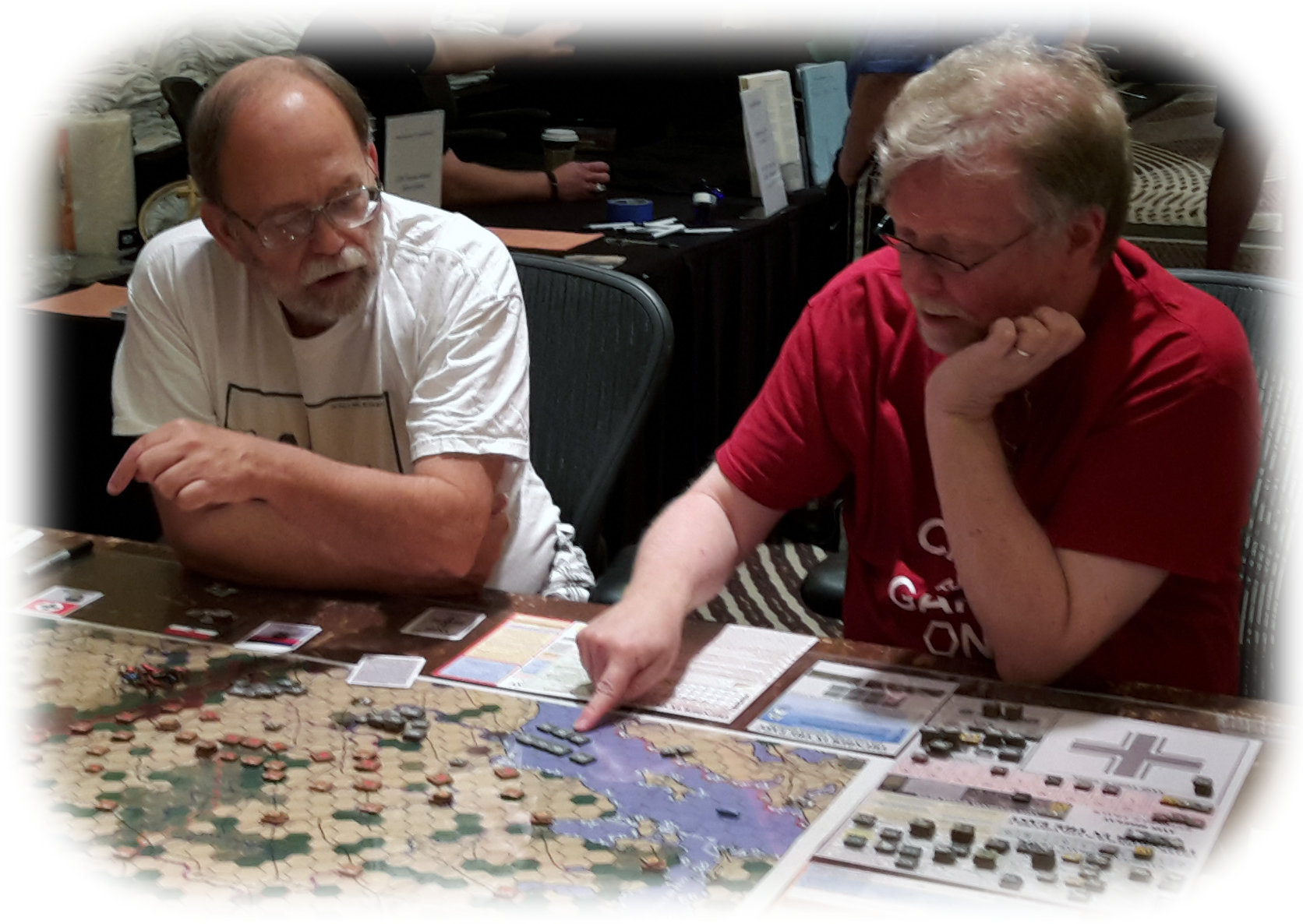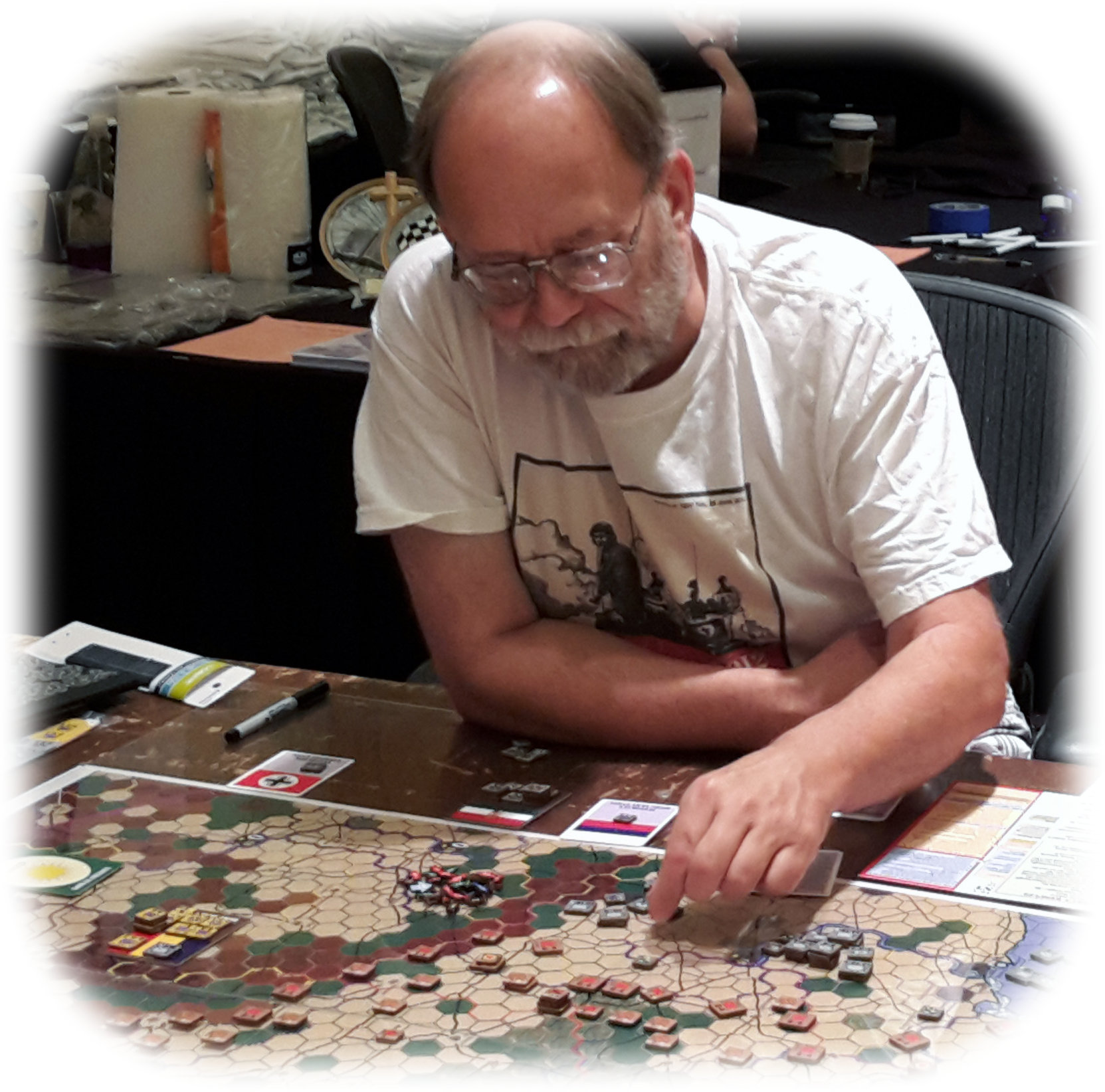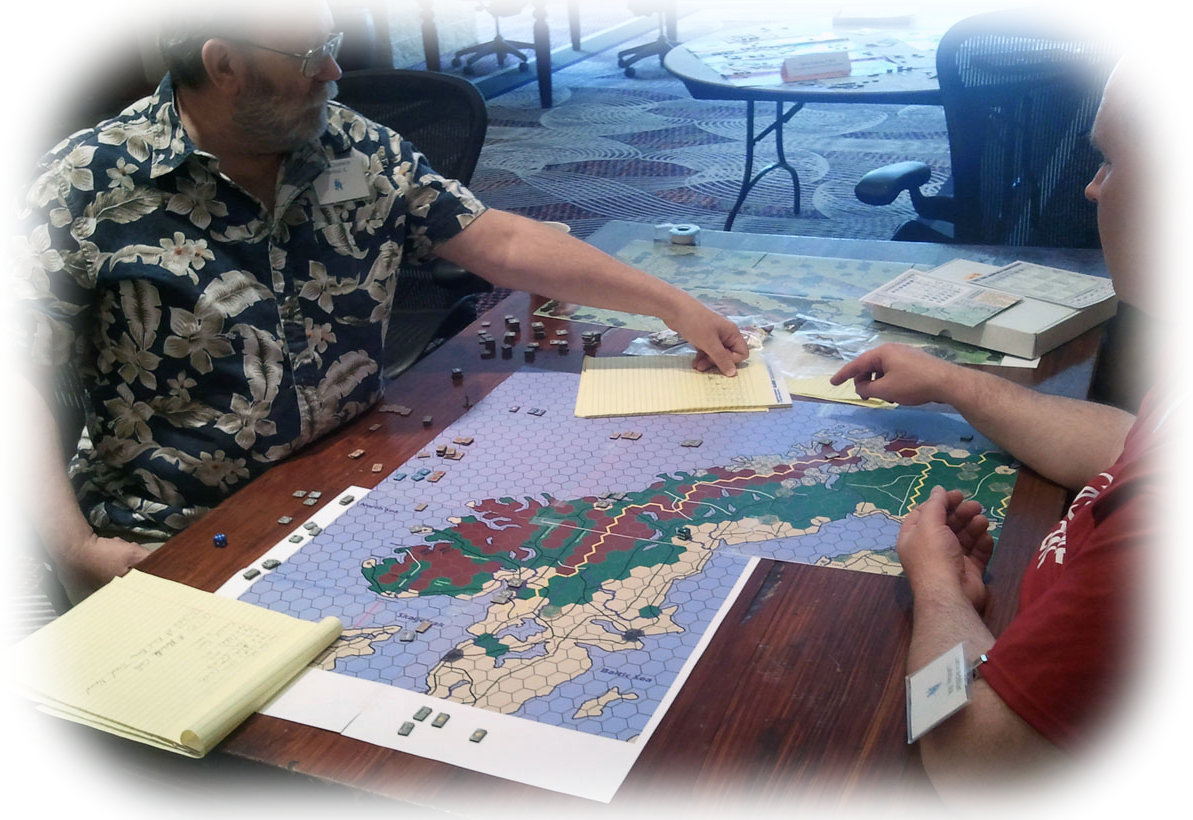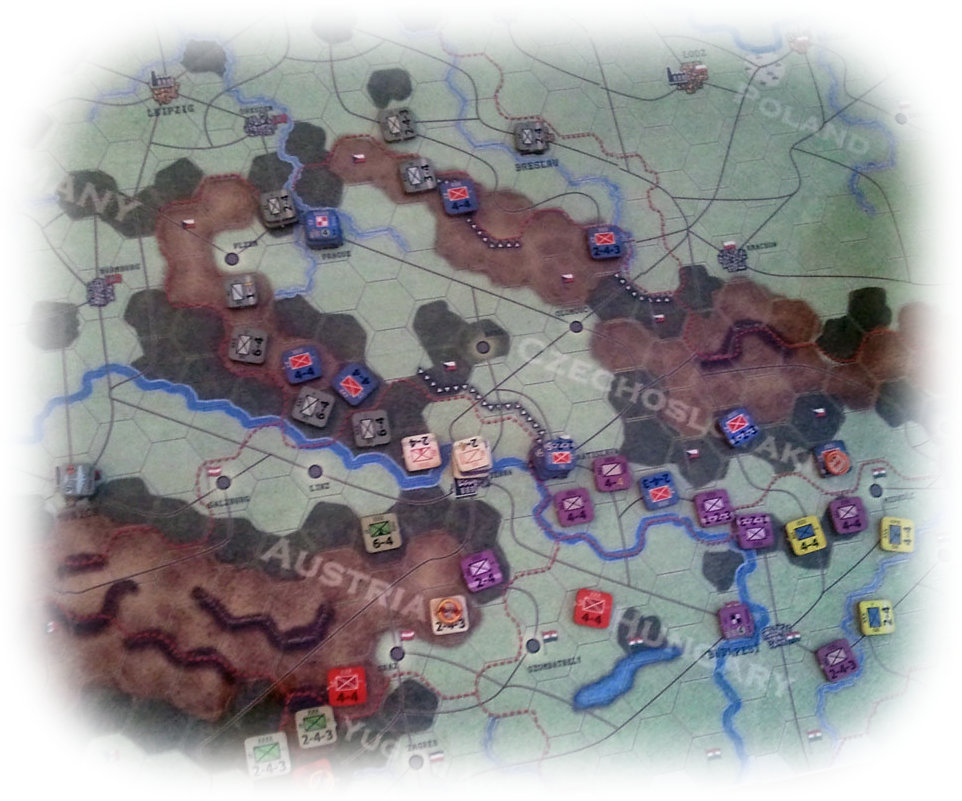Grognard.com: After Game Designer’s Workshop went dark, the board wargaming hobby sort
of lost track of you. Now you're back! And the man who brought us the first “monster” wargames (the Europa series) is now,
40+ years later, doing it again with your new ETO series. First, what brought you back into our hobby after the GDW hiatus?
Did you miss us?
Frank Chadwick: I was never completely out of the hobby, although I spent the bulk of my
time in miniatures gaming, and still do. However, and this will sound strange given the current project, my tastes now generally
run to the smaller and less complicated games. That's why I began doing games for Victory Point Games,
and I did a half dozen or so for them before we embarked upon this monster-game project. Although, to be fair, even as a monster game,
ETO is just a very simple, straightforward system writ large, with the necessary logistical support added.

Grognard.com: Straight up, what are you thinking, making another monster-size WWII game after
all this time? How will this be different from your previous opus, the Europa series? Inquiring wargamers want to know!
Frank Chadwick: What am I thinking? I'll resist the urge to say "do it right," for two reasons.
First, lots of gamers still love Europa, and I do as well. ETO is not an attempt to "fix" Europa. Second, this is a different
approach, and I like to think it's different because I've learned a few things in the forty-some years since we started Drang
Nach Osten.
So how is ETO different? Most obviously, it's one level higher in unit representation (corps are the most common unit level, as
opposed to divisions) and the hexes represent about twice the landscape (side-to-side) as in Europa. Interestingly, the turns
represent only half the time (about a week in ETO as opposed to two weeks in Europa). However, a big difference is that hardly
anything below the nominal scale of the game is represented at all. All of that is subsumed into the "main sequence" of game units.
When we say it is a corps/army level game, that means that in the main theaters you are dealing almost exclusively with corps
and armies. The effect is visually striking, and I really like it. ETO doesn’t look like how most wargamers envision a
"monster game" looking because the unit density is very low. You will not see continuous "walls" of counters opposing each
other. Instead, there are gaps in the front line and most hexes which have units have only a single one. ETO is a game of
maneuver, it presents times of open field running and only rarely of battering down a position by brute attrition.
Grognard.com: Wargame designers must love historical research. How much better are the
information sources you’re using to make Frank Chadwick’s ETO series than you had available back in the Game Designer’s
Workshop days? Is that impacting the game’s orders of battle, map, and scenarios noticeably from the wargames of yesteryear?
Frank Chadwick: Good question! The internet has made a huge difference in terms of
convenience of access, but the sorts of information readily available online are surprisingly spotty, they are also
skewed toward popular subjects rather than what might be needed. For the most part, wargame designers still need
to crack books.
The real revolution has come from increased access to the former Soviet archives. That started back in the 70s with
John Erickson's pioneering work and David Glantz (foremost among others) has continued that work. From a game designer's
perspective, I find the single most useful source on the Red Army is Charles Sharpe's twelve-volume series on the
Red Army Order of Battle. It's an amazing piece of work and the level of detail in the game's Soviet ground forces,
at both the overall level and the scenario level, just wouldn't have been possible without it.
The German stuff has been out there a long time, and although there's a lot of good new scholarship, the corps-level
order of battle document which is the game's "Bible" for the German Army is a giant three-page chart showing every
German corps and its assignment (including whether it is in existence, forming, destroyed) for every month of the
war. That's a document I assembled years ago, mostly from Georg Tessin's Verbände und Truppen der Deutschen Wehmacht und
SS im Zweiten Weltkrieg, 1939-1945, back at GDW when John Astell and I were working on a never-published game also to
be called, interestingly enough, ETO.
As to the armies of the many lesser nations, the information is there somewhere, but when you're doing one game covering
all of them you don't really have time to do the research for a doctoral dissertation on each one of them. That's where
internet sites like Dr. Leo Niehorster's World War II Armed Forces become particularly valuable. He doesn't have everything
you need about, say, the Bulgarian Army, but at corps-level he's awfully close. There are still gaps, still digging that
you have to do, but those sorts of online resources save months of research.
The main problem remains that information needed for a particular wargame design is often not exactly what authors are
interested in talking about. Even something as simple as the total authorized and operational strength of the Red Air
Force at key points in the war remains surprisingly elusive, as do things like resource and industrial output of the
entire range of belligerent nations and on a constant system. If you are trying to find out how many million tons of
oil the various nations pumped per year during the war, it’s amazing how many different numbers you can come up with.

Grognard.com: Frank, you have a legendary reputation among wargamers as a smart “systems and
mechanics” guy. I understand that ETO is a big evolutionary advance from 1986’s Battle for Moscow that this particular
move-fight-move system evolved from. What new systems and mechanics that you created for Thunder in the East (TITE) are
the playtesters excited about?
Frank Chadwick: The air system, for starters. It's really slick and really fun. Since it uses
counters identified as particular aircraft models, it has lots of historical feel and color. And since it uses a theater basing
and readiness approach (owing a lot to the Third World War series), it is mechanically very easy without a lot of on-map fussing
around. The playtesters love the air system.
The supply system is, in some ways, the heart of the game, but it's a very rules-light and effect-heavy system. There is very
little in the way of mechanics to worry about, but the decisions you make have very powerful effects and give the ground game a
lot of its sense of historical verisimilitude. That feature has gotten very high marks as well.
At playtester suggestion, we've added a corps cadre system (on on-map remnants of destroyed corps) which, for Soviet armies, is
an untried corps unit. Those additions have added more resilience to the armies and some additional game uncertainty. Since those
suggestions came from playtesters, I'm pretty sure they like them.
Grognard.com: Following up that last question, the other games in the ETO series will feature
naval operations and, when connected, there will need to be some sort of strategic warfare systems. Are those on the drawing
board? How will they play?

Frank Chadwick: They're more than on the drawing boards. The strategic resource and production
system will be there to see in Thunder in the East as the Soviet Union's entire economic base is in play (there is really
no reason to leave it out). The Axis resource generation system simplifies down to an appropriate allotment of resources on a
fixed schedule from off-map, but the production system (how they use those resources) is there as it would be in the Campaign Game.
tg
The strategic bombing rules will be there in TITE as well, as they aren’t that complicated – it is just that nobody has enough
of a strategic bombing force in this game to exploit them fully. There were some pin-prick raids on Moscow, Bucharest, and Ploesti,
and in the game those make sense. However, once you can blacken the skies with Liberators and Fortresses, the cumulative impact
of those raids starts changing.
We have abstracted the naval system for TITE, mostly because since it is such a small part of the game (a big set of naval
rules would just be a distraction). That said, you will see the naval system in all (or at least most) of its glory in The Middle
Sea, the next big installment. The only part you probably won't see until the last installment is the oceanic convoy system, which
already exists (people played with it a bit back at ConSimWorld Expo 2015).
Grognard.com: The name of the game (series) is Frank Chadwick’s ETO. Please take a step
back, wave your arm at the distant horizon, and give us “the big picture” for this series. How many titles will there be in it?
What will they cover? And when it’s all said and done, how do you see it playing in the lives of wargamers?
Frank Chadwick: Originally we were going to do a bunch of smallish games, but I think we started
realizing it would take more years than any of us felt we could invest. It is also hard to sustain gamer interest in a series
which, like as not, will take over a decade to complete. Therefore, the current plan is four games and then a strategic wrap-up
module. The four games are:
1. Thunder in the East (TITE): The entire Eastern Front from 1941-45.
2. The Middle Sea (TMS): The Mediterranean and North Africa, including the Balkans and Italy, 1940-45.
3. Fall of the West (FOTW): Northwest Europe in 1940 and again in 1944-45, with the possibility of a 1943 invasion as a what-if.
4. Northern Fire (NF): Scandinavia and Finland, covering the 1939 Winter War, the 1940 Norway Campaign, the 1941-44 Continuation War, and a couple hypothetical invasions of Sweden.
The strategic wrap-up adds the convoy system and the Battle of the Atlantic. Of course, it also shows how to put it all together and
link the four games, but by that time it will be fairly obvious how that will happen if you've played along with the ETO series the
whole time.
After that, we will almost certainly add the prequel game, Dark Beginnings, which presents myriad run-up scenarios to war in
the 1930s, and all the different ways that WWII in Europe could have started. If we are really crazy, we might include the information
necessary to start ETO from any of those starting points (but no promises).

I don't know that one-size-fits-all makes much sense in gaming anymore, so we're trying to make it as easy as possible for players
to decide how they want to configure this for themselves. We have multiple scenarios in each game, and each scenario is also a
possible start date for the entire game, either in that particular game or the whole ETO campaign. So, if you want to start
the who thing off with Kursk (July of 1943), you can do that in the east, or you can add The Middle Sea and also set up
for Operation Huskey (the invasion of Sicily), or also add in Fall of the West and see if you want throw the dice on an
early landing in France instead of Sicily/Italy, or add Northern Fire and … well, you get the idea.
Grognard.com: You’ve designed a lot of WWII games, Frank. Do you have a favorite theater or
campaign and game scale? What kind of WWII games did you most enjoy making? And what kind of WWII games do you most enjoy playing?
Frank Chadwick: My sentimental favorite is North Africa. In part because the old Avalon
Hill Afrika Korps was the first wargame I played, and it's still my favorite of those older AH games. I think Tom Shaw
did as good a job capturing the flavor of that campaign (at least as we understood it back then, viewed through the lenses of
Desmond Young and Paul Carell) as anyone ever has. John Edwards came close in African Campaign.
I don't think you can beat the Eastern Front for variety of situations and drama, but I am more interested in the US
Army than any other, more so as I've learned more about the war. So all those different interests pull me in different
directions, and I guess keep me from falling into a rut.
As to scale, I don’t have a clear preference, although I like to have a sense of operational maneuver and the sweep of
a campaign. Division level and corps level can pull that off, provided the designer has that in mind. I like simple mechanics,
but I don’t care for particularly abstract ones. I like to have a sense that the mechanics of what I'm doing has a strong
relation to the actual decision-making, what Alan Emrich calls “a strong game narrative.”
Grognard.com: You have a strong, longstanding wargamer fan base. When they play Frank Chadwick’s ETO,
what aspects of it will feel very familiar and comfortable, and what might be a real departure for them, based on your corpus of
published wargame designs?
Frank Chadwick: I suppose that depends on which of my games they prefer. My preference for mechanics
which reflect process—as opposed to abstract mechanics which produce a result but without as much feel for how you got there—remain
the same as always, and I think everyone who's played my games over the years will recognize that. Sure, I design for effect, but
getting to the effect is half the fun.
As to the rest, I'd say that more players liked my designs which tended to be less cluttered with detailed mechanics and more tightly
focused on the strategic decision-making of the player—games like A House Divided, Bloody Kasserine, Race For Tunis,
The Sands of War series, all the games I've done for Victory Point Games,
and of course Battle For Moscow, will find this pretty familiar going.
If a player is expecting Operation Crusader writ even larger (much as I love that design), they will be disappointed.